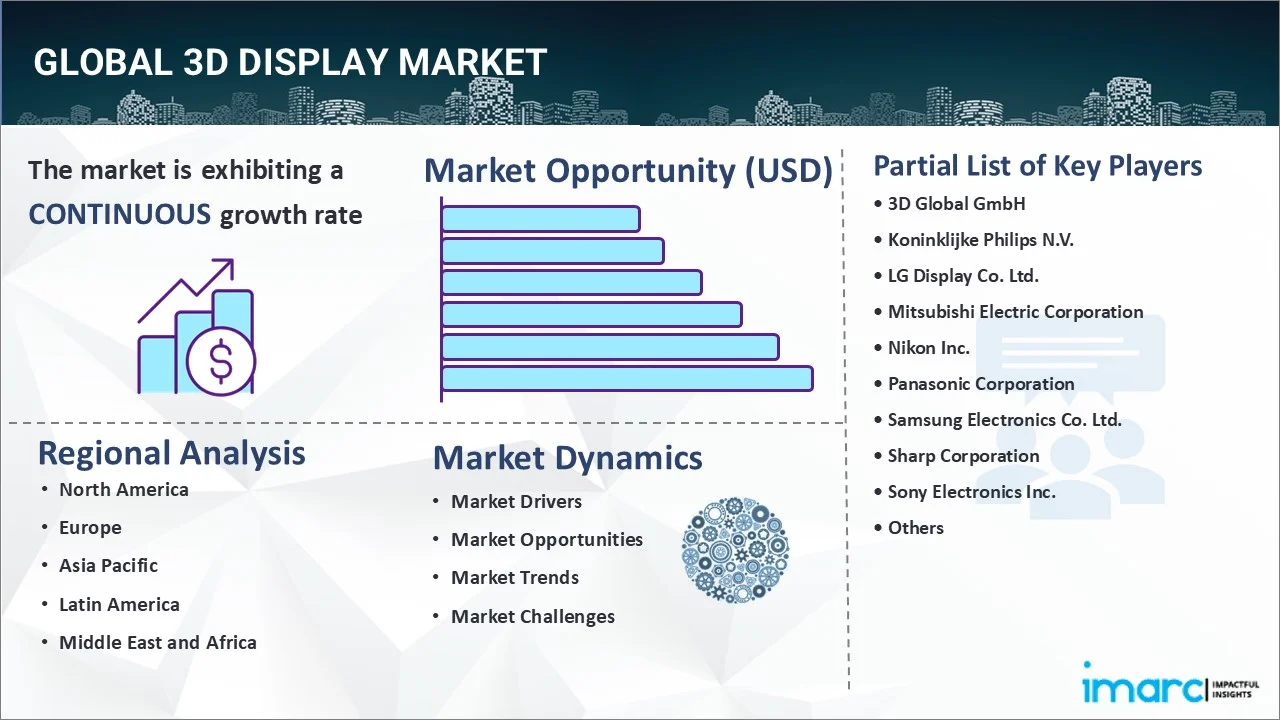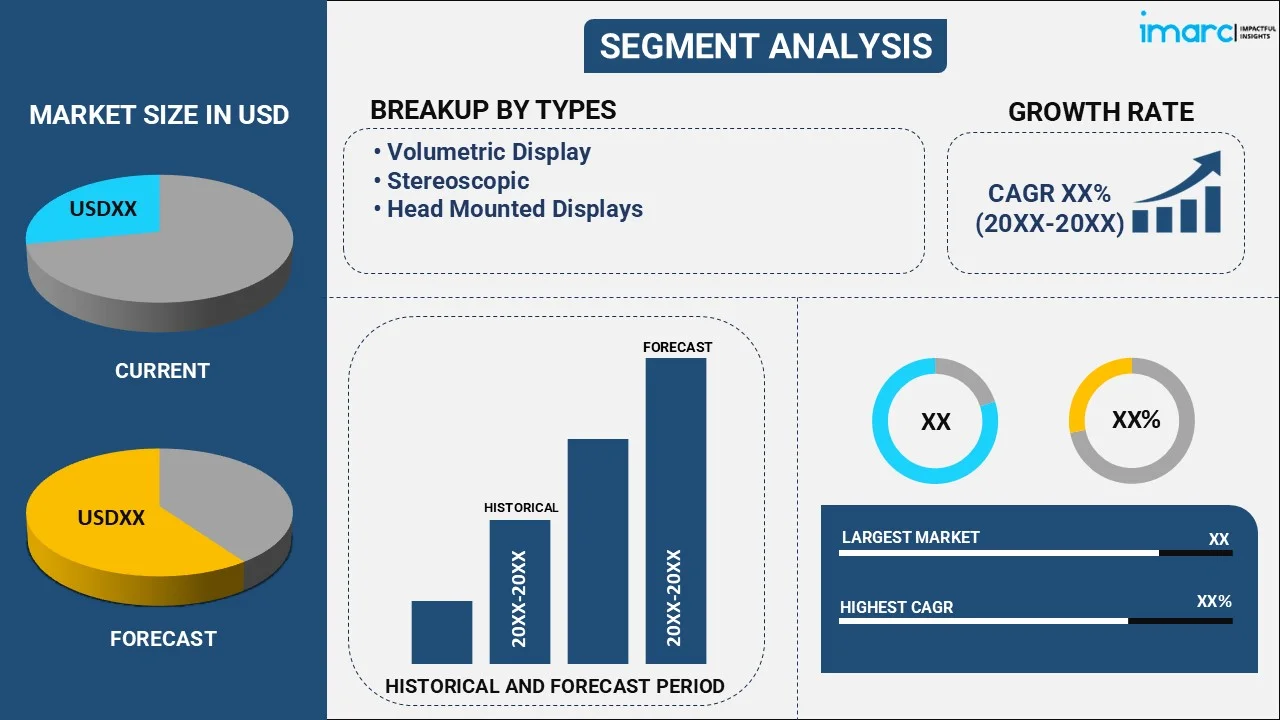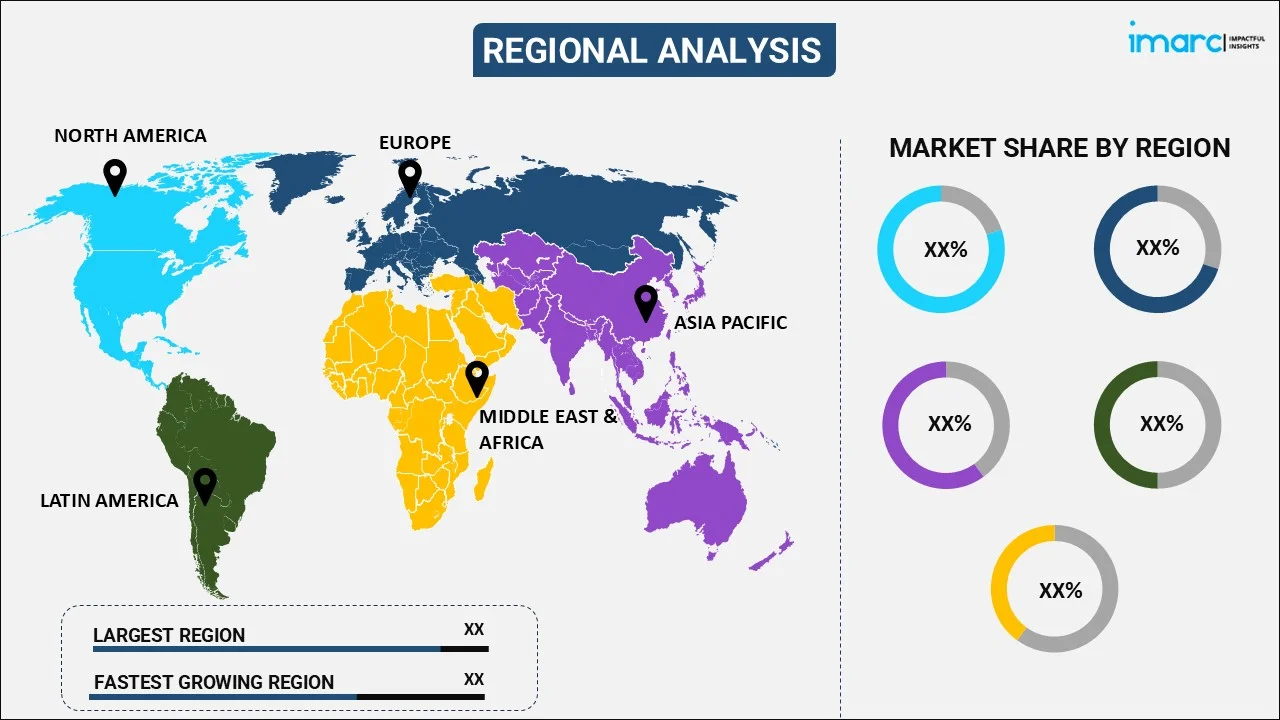
3D Display Market Report by Type (Volumetric Display, Stereoscopic, Head Mounted Displays), Technology (Digital Light Processing, Plasma Display Panel, Organic Light Emitting Diodes (OLEDs), Light Emitting Diode (LEDs)), Access Method (Conventional/Screen Based Display, Micro Displays), Application (Televisions, Smartphones, Monitors, Mobile Computing Devices, Projectors, and Others), and Region 2025-2033
3d Display Market Size:
The global 3D display market size reached USD 192.2 Billion in 2024. Looking forward, IMARC Group expects the market to reach USD 633.1 Billion by 2033, exhibiting a growth rate (CAGR) of 14.2% during 2025-2033. The increasing adoption of 3D display across numerous industries, advancements in computer technology, and the burgeoning gaming industry represent some of the key factors driving the market.
|
Report Attribute
|
Key Statistics
|
|---|---|
|
Base Year
|
2024
|
|
Forecast Years
|
2025-2033
|
|
Historical Years
|
2019-2024
|
|
Market Size in 2024
|
USD 192.2 Billion |
|
Market Forecast in 2033
|
USD 633.1 Billion |
| Market Growth Rate 2025-2033 | 14.2% |
A 3D display is a technology that allows users to see and interact with images or videos in a three-dimensional space. It provides tools to visualize and understand complex high-dimensional data and objects and create the illusion of depth by presenting different images to each eye and creating a stereoscopic effect that mimics the way human vision works in the real world. It also facilitates an immersive and engaging viewing experience using digital light processing, plasma display panels, organic light-emitting diodes (OLEDs), and light-emitting diodes (LEDs). At present, it is widely employed in televisions, smartphones, monitors, mobile computing devices, and projectors.

3D Display Market Trends:
Growing Demand for High-resolution and Large Screen Displays
With the increasing consumer demand for immersive solutions, there is a rapid uptrend toward 3D displays offering high-resolution and large-screen experiences. The cost-effective development of larger screen sizes and panels offering exceptional resolution is significantly driving this trend. Further, the surge in popularity of high-definition gaming experiences is steering the demand for more detailed and immersive displays. The growth in demand for home theatre systems is also supplementing the growth of large screen 3D displays. The integration of augmented reality (AR) and virtual reality (VR) devices is further creating growth opportunities for the 3D display market leaders.
Increasing Adoption of 3D Displays Across Diverse Industries
At present, the increasing adoption of 3D displays in various industries, such as gaming, healthcare, automotive, aerospace, and defense due to their ability to provide a more immersive and engaging experience is catalyzing the market growth. Apart from this, the integration of advanced technologies, such as VR and AR, across various industry verticals are positively influencing the expansion of the 3D display market size. Additionally, the rising usage of 3D displays by manufacturers for advertising and marketing for increasing sales and brand awareness is propelling the growth of the market. Besides this, rise in the demand for 3D display technologies in home entertainment electronic devices, coupled with inflating disposable incomes and easy availability of devices, are bolstering the market growth. Apart from this, increasing advancements in computer technology and the rapid development of the gaming industry are fueling the market growth worldwide.
Technological Advancements
The ongoing advancements in 3D display technology, such as autostereoscopic displays, holographic displays, and volumetric displays, that offer improved content quality, in confluence with their increasing accessibility and rising affordability, are creating a favorable market outlook. Moreover, leading players are introducing innovative and cost-effective 3D display technologies that do not require continuous electricity. As these technologies are safe, reliable, and offer increased depth perception, they are gaining immense traction among doctors to perform surgeries. Furthermore, the increasing utilization of representational models, visuals, and movies in design, engineering, computer-aided design (CAD), computer-aided manufacturing (CAM), and simulation applications, along with the rising utilization of 3D display technologies in capturing and editing videos and photography, is stimulating the market growth.
Key Market Segmentation:
IMARC Group provides an analysis of the key trends in each sub-segment of the global 3D display market report, along with forecasts at the global, regional and country level from 2025-2033. Our report has categorized the market based on type, technology, access method and application.
Type Insights:

- Volumetric Display
- Stereoscopic
- Head Mounted Displays
The report has provided a detailed breakup and analysis of the 3D display market based on the type. This includes volumetric displays, stereoscopic, and head mounted displays. According to the report, stereoscopic represented the largest segment.
Technology Insights:
- Digital Light Processing
- Plasma Display Panel
- Organic Light Emitting Diodes (OLEDs)
- Light Emitting Diode (LEDs)
The report has provided a detailed breakup and analysis of the 3D display market based on the technology. This includes digital light processing, plasma display panel, organic light emitting diodes (OLEDs), and light emitting diode (LEDs).
Access Method Insights:
- Conventional/Screen Based Display
- Micro Displays
A detailed breakup and analysis of the 3D display market based on the access method has also been provided in the report. This includes conventional/screen based display and micro displays. According to the report, conventional/screen based display accounted for the largest market share.
Application Insights:
- Televisions
- Smartphones
- Monitors
- Mobile Computing Devices
- Projectors
- Others
The report has provided a detailed breakup and analysis of the 3D display market based on the application. This includes televisions, smartphones, monitors, mobile computing devices, projectors, and others. According to the report, televisions accounted for the largest market share.
Regional Insights:

- North America
- United States
- Canada
- Asia-Pacific
- China
- Japan
- India
- South Korea
- Australia
- Indonesia
- Others
- Europe
- Germany
- France
- United Kingdom
- Italy
- Spain
- Russia
- Others
- Latin America
- Brazil
- Mexico
- Others
- Middle East and Africa
The report has also provided a comprehensive analysis of all the major regional markets, which include North America (the United States and Canada); Asia Pacific (China, Japan, India, South Korea, Australia, Indonesia, and others); Europe (Germany, France, the United Kingdom, Italy, Spain, and others); Latin America (Brazil, Mexico, and others); and the Middle East and Africa. According to the report, Asia Pacific was the largest market for 3D display. Some of the factors driving the Asia Pacific 3D display market include significant growth in the entertainment and gaming industries, advancements in 3D technology, increasing adoption of 3D displays across numerous industries, etc.
Competitive Landscape:
The report has also provided a comprehensive analysis of the competitive landscape in the global 3D display market. Competitive analysis such as market structure, market share by key players, player positioning, top winning strategies, competitive dashboard, and company evaluation quadrant has been covered in the report. Also, detailed profiles of all major companies have been provided. Some of the companies covered include 3D Global GmbH, Koninklijke Philips N.V., LG Display Co. Ltd., Mitsubishi Electric Corporation, Nikon Inc., Panasonic Corporation, Samsung Electronics Co. Ltd., Sharp Corporation, Sony Electronics Inc., The Coretec Group Inc, Toshiba Corporation, etc.
Report Coverage:
| Report Features | Details |
|---|---|
| Base Year of the Analysis | 2024 |
| Historical Period | 2019-2024 |
| Forecast Period | 2025-2033 |
| Units | Billion USD |
| Segment Coverage | Type, Technology, Access Method, Application, Region |
| Region Covered | Asia Pacific, Europe, North America, Latin America, Middle East and Africa |
| Countries Covered | United States, Canada, Germany, France, United Kingdom, Italy, Spain, Russia, China, Japan, India, South Korea, Australia, Indonesia, Brazil, Mexico |
| Companies Covered | 3D Global GmbH, Koninklijke Philips N.V., LG Display Co. Ltd., Mitsubishi Electric Corporation, Nikon Inc., Panasonic Corporation, Samsung Electronics Co. Ltd., Sharp Corporation, Sony Electronics Inc., The Coretec Group Inc and Toshiba Corporation |
| Customization Scope | 10% Free Customization |
| Post-Sale Analyst Support | 10-12 Weeks |
| Delivery Format | PDF and Excel through Email (We can also provide the editable version of the report in PPT/Word format on special request) |
Key Benefits for Stakeholders:
- IMARC’s report offers a comprehensive quantitative analysis of various market segments, historical and current market trends, market forecasts, and dynamics of the 3D display market from 2019-2033.
- The research study provides the latest information on the market drivers, challenges, and opportunities in the global 3D display market.
- The study maps the leading, as well as the fastest-growing, regional markets. It further enables stakeholders to identify the key country-level markets within each region.
- Porter's five forces analysis assist stakeholders in assessing the impact of new entrants, competitive rivalry, supplier power, buyer power, and the threat of substitution. It helps stakeholders to analyze the level of competition within the 3D display industry and its attractiveness.
- Competitive landscape allows stakeholders to understand their competitive environment and provides an insight into the current positions of key players in the market.
Key Questions Answered in This Report
The global 3D display market was valued at USD 192.2 Billion in 2024.
We expect the global 3D display market to exhibit a CAGR of 14.2% during 2025-2033.
The rising adoption of 3D displays across various industries, such as gaming, healthcare, automotive, aerospace, etc., owing to their ability to provide a more immersive and engaging experience, is primarily driving the global 3D display market.
The sudden outbreak of the COVID-19 pandemic had led to the implementation of stringent lockdown regulations across several nations, resulting in the temporary closure of numerous manufacturing units for 3D displays.
Based on the type, the global 3D display market has been segmented into volumetric display, stereoscopic, and head mounted displays. Among these, stereoscopic currently holds the majority of the total market share.
Based on the technology, the global 3D display market can be divided into digital light processing, plasma display panel, Organic Light Emitting Diodes (OLEDs), and Light Emitting Diode (LEDs). Currently, Light Emitting Diode (LEDs) exhibits a clear dominance in the market.
Based on the access method, the global 3D display market has been categorized into conventional/screen based display and micro displays, where conventional/screen based display currently accounts for the largest market share.
Based on the application, the global 3D display market can be segregated into televisions, smartphones, monitors, mobile computing devices, projectors, and others. Currently, televisions exhibit a clear dominance in the market.
On a regional level, the market has been classified into North America, Asia-Pacific, Europe, Latin America, and Middle East and Africa, where Asia-Pacific currently dominates the global market.
Some of the major players in the global 3D display market include 3D Global GmbH, Koninklijke Philips N.V., LG Display Co. Ltd., Mitsubishi Electric Corporation, Nikon Inc., Panasonic Corporation, Samsung Electronics Co. Ltd., Sharp Corporation, Sony Electronics Inc., The Coretec Group Inc, Toshiba Corporation, etc.
Need more help?
- Speak to our experienced analysts for insights on the current market scenarios.
- Include additional segments and countries to customize the report as per your requirement.
- Gain an unparalleled competitive advantage in your domain by understanding how to utilize the report and positively impacting your operations and revenue.
- For further assistance, please connect with our analysts.
 Request Customization
Request Customization
 Speak to an Analyst
Speak to an Analyst
 Request Brochure
Request Brochure
 Inquire Before Buying
Inquire Before Buying




.webp)




.webp)












